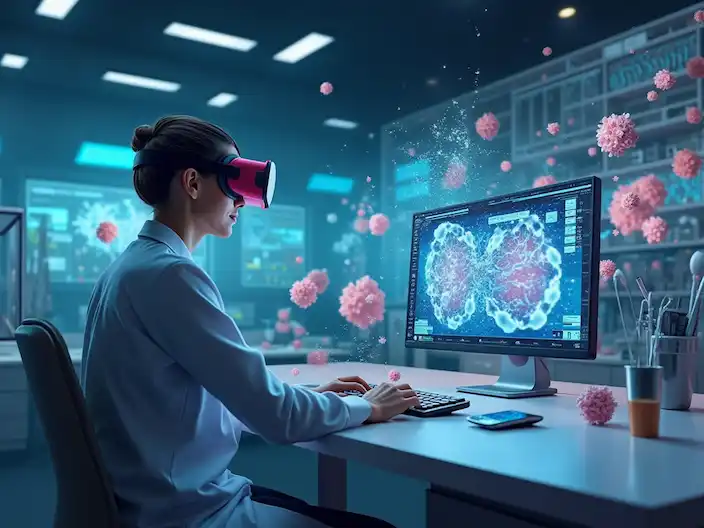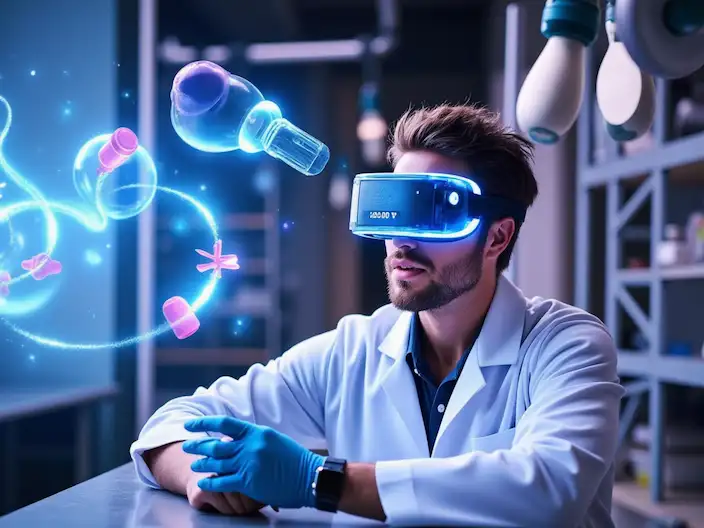Abstract
In recent years, remarkable advancements in metaverse technologies and quantum-molecular computing have opened new horizons in scientific simulations. The metaverse, as an interactive virtual reality platform, can provide simulated environments for scientific experiments where molecular models at the nanoscale and quantum scale can be studied. This article examines the integration of molecular computing with the metaverse and explores the potential for creating quantum-molecular environments to analyze biological, chemical, and pharmaceutical reactions. It also analyzes the challenges and opportunities presented by this technology in improving research processes, data security, and the interaction between biological systems and virtual environments.
1. Introduction
1.1 Technological Advancements and the Necessity of Combining the Metaverse with Molecular Computing
In recent decades, advancements in digital technologies and the emergence of quantum computing have created new opportunities for scientific fields, particularly in biology, chemistry, medicine, and molecular physics. On the other hand, the Metaverse, as an advanced virtual platform, enables interaction, simulation, and the execution of complex experiments in a digital environment. This can overcome physical limitations and optimize research processes. By combining quantum and molecular technologies with the Metaverse, it becomes possible to create simulated quantum-molecular environments that can revolutionize methods of scientific research and development.
1.2 Challenges in Molecular Computing and the Importance of the Metaverse in Addressing Them
Molecular computing is a key domain in computational biology and chemistry, focusing on analyzing and predicting molecular behaviors in chemical reactions, drug design, and modeling biological processes. Due to the high complexity of molecular interactions and the vast number of influencing variables, these computations demand immense processing power. Despite significant advancements, supercomputers and traditional processing methods still face multiple challenges in addressing certain molecular computation issues, such as:
- Long processing times for complex simulations,
- Limitations in storing massive molecular data,
- High costs of conducting real-world experiments,
- Low accuracy in simulations based on classical algorithms.
The Metaverse can serve as a platform where molecular simulations on a quantum scale are executed in a fully interactive three-dimensional virtual space. In this environment, researchers can visually examine molecular models in a digital space and perform a more precise analysis of chemical and biological behaviors.
1.3 The Role of Quantum Computing in Metaverse Molecular Modeling
Quantum computing, with capabilities such as superposition and entanglement, has addressed the limitations of traditional methods. This technology allows molecular systems to be modeled with extremely high accuracy in a shorter time. In the Metaverse, leveraging the Quantum Metaverse (QMV) enables molecular data to be simulated with quantum precision and interactive experiments to be conducted virtually without relying on physical environments.
Some benefits of utilizing quantum computing in the Metaverse for molecular modeling include:
- Increased processing speed and data analysis: Quantum bits (qubits) allow parallel processing, significantly reducing analysis time.
- Higher accuracy in predicting molecular behavior: Unlike classical processors, quantum computing enables simultaneous exploration of all possible states of a system.
- Interactive exploration in three-dimensional virtual environments: Researchers can examine molecules in a Metaverse space and observe reaction changes in real-time.
- Reduced research costs: Molecular simulations in the Metaverse minimize the need for costly physical laboratory experiments, accelerating the development of new drugs and materials.

1.4 The Future of Scientific Research in the Metaverse
Today, major technology companies and research centers are investing in the development of the Scientific Metaverse. This concept includes creating virtual laboratories, conducting collaborative research within the Metaverse, and utilizing artificial intelligence and machine learning for molecular data analysis. In the future, it is expected that physical laboratories and research centers will be able to perform precise molecular simulations in a digital environment while simultaneously accessing quantum-processed data.
Therefore, the integration of the Metaverse and molecular computing not only advances scientific progress but also paves the way for more precise, faster, and cost-effective research in fields such as chemistry, biology, pharmaceuticals, and medicine.
2. Quantum-Molecular Computing in the Metaverse
The combination of quantum computing technologies and the metaverse has opened new horizons in molecular modeling, simulating chemical and biological reactions, and optimizing scientific processes. This section explores the principles of quantum computing in molecular modeling, its implementation in the metaverse, and the benefits of this integration for life sciences and chemistry.
2.1 Fundamentals of Quantum Computing and Its Connection to Molecular Modeling
Quantum computing is one of the most advanced branches of computational science, utilizing the principles of quantum mechanics to process information. Unlike classical computers that operate on binary bits (0 and 1), quantum computers use qubits, which can exist in multiple states simultaneously. This capability allows quantum computers to perform highly complex calculations at speeds exponentially faster than classical computers.
Molecular modeling is a field heavily reliant on high computational power. Interactions between molecules and atoms are influenced by electrostatic forces, chemical bonds, and electron transfer processes, which are extremely challenging to simulate using traditional methods due to the inherent complexity of molecular systems. Quantum computing, by directly simulating these processes, offers an optimal solution to these challenges.
Key applications of quantum computing in molecular modeling include:
✅ Accurate simulation of chemical reactions: Quantum models can precisely predict bond energies, molecular orbital changes, and reaction pathways.
✅ Modeling complex molecular structures: Quantum computers can simulate biomolecular structures such as proteins and DNA.
✅ Optimization of pharmaceutical compounds: By analyzing molecular interactions at the quantum level, new, more effective drugs can be discovered.
✅ Modeling quantum phenomena in biology: Biological processes like photosynthesis and information transfer in neurons exhibit quantum behaviors, which require quantum computing for simulation.
2.2 The Role of the Metaverse in Molecular Simulation and Modeling
The metaverse, as an advanced virtual environment, can play a crucial role in facilitating scientific simulations. In metaverse-based 3D environments, scientists can visually observe molecular models and analyze their changes in real time. This capability transforms research processes from static and linear methods into a fully interactive workflow, where researchers can directly engage with scientific data.
Key features of the metaverse in molecular modeling include:
✅ Virtual laboratories for molecular simulation: Scientists can simulate and analyze chemical reactions in a virtual environment, eliminating the need for costly physical labs.
✅ Interactive 3D environments: Researchers can interact with molecular structures and observe their changes in real time within the metaverse.
✅ Global scientific collaboration: Researchers from around the world can simultaneously conduct research and experiments in a shared metaverse environment, enhancing international collaboration.
✅ Integration with quantum computing for improved accuracy: Combining the metaverse with quantum computers maximizes the precision of molecular modeling and simplifies complex analyses.

2.3 Integrating Quantum Computing with the Metaverse for Quantum-Molecular Environments
To implement quantum computing in the metaverse, hybrid models have been developed that integrate quantum computing data into 3D metaverse environments. One such innovative model is the Quantum Metaverse (QMV), which enables the creation of simulated environments on a quantum scale.
Key components of QMV for molecular simulations include:
- Quantum processing engine: Incorporates quantum algorithms for analyzing bond energies, molecular structures, and reaction pathways.
- Molecular visualization system in the metaverse: 3D models that display molecular changes in real time.
- Interactive user interface: Allows researchers to explore, modify, and optimize molecular structures in a fully interactive environment.
- Quantum molecular database: A database storing and processing data from quantum simulations.
2.4 Advantages of Quantum-Molecular Computing in the Metaverse
✅ High speed and efficiency: The integration of quantum computing with the metaverse accelerates computational processes and performs complex calculations in less time.
✅ Improved accuracy and reduced errors: Quantum simulations in the metaverse enhance prediction accuracy and prevent computational errors.
✅ Cost-effective virtual experimentation: Expensive chemical and biological experiments can be simulated in the metaverse, reducing research costs.
✅ Optimized drug and biomaterial design: Combining quantum computing and the metaverse offers new solutions for designing highly efficient drugs and biomaterials.
✅ Global collaboration in life sciences and chemistry: Scientists worldwide can access quantum computing results and participate in joint research projects through the metaverse.
2.5 Challenges of Implementing Quantum Computing in the Metaverse
Despite significant advancements, challenges remain in the development and implementation of quantum-molecular computing technologies in the metaverse:
- Hardware limitations of quantum computers: This technology is still in development and requires advancements in qubit stability and processing power.
- Data security and privacy: Given the sensitivity of nanoscale molecular modeling, advanced encryption is essential to protect data.
- Compatibility between metaverse software and quantum algorithms: Developing seamless integration between 3D models and quantum processing requires ongoing optimization.
3. Creating Quantum-Molecular Environments in the Metaverse
In recent years, the Metaverse has transcended its initial role as a platform for entertainment and social interaction, becoming a space for scientific research, education, and complex simulations. By integrating the Metaverse with quantum and molecular computing, simulated quantum-molecular environments can be developed, potentially revolutionizing fields such as life sciences, chemistry, pharmacology, and molecular physics. This section examines the architecture of these environments, design challenges, practical applications, and the future of this technology.
3.1 Architecture of Quantum-Molecular Environments in the Metaverse
Quantum-molecular environments in the Metaverse require a structure capable of processing quantum data, rendering real-time molecular models, and enabling researchers to interact and conduct virtual experiments. These environments are typically composed of several layers, as outlined below:
3.1.1 Quantum Computing Layer
This layer comprises quantum processors responsible for executing molecular computations. Quantum computing in these environments can be applied to:
- Analyzing molecular interactions at the quantum level,
- Predicting complex biomolecular structures,
- Optimizing pathways for chemical reactions,
- Modeling biological processes like photosynthesis and neural signal transmission.
3.1.2 Metaverse Interaction Layer
This layer handles the visualization of 3D molecular models and facilitates interaction with them. Key features of this layer include:
- Accurate real-time visualization of molecular structures and their changes,
- Interactive tools for observing, analyzing, and manipulating molecular models,
- Virtual Reality (VR) and Augmented Reality (AR) environments for immersive scientific research experiences.
3.1.3 Data & Networking Layer
This layer consists of databases storing information related to quantum and molecular simulations. It also enables high-speed networking to connect users, researchers, and Metaverse laboratories seamlessly.

3.1.4 Security & Quantum Encryption Layer
Given the sensitive nature of data processed in Metaverse environments, robust security systems are essential. Security technologies used in these environments include:
- Quantum encryption to protect molecular data,
- Blockchain-based authentication systems to ensure researcher credibility,
- Security protocols to prevent cyberattacks on Metaverse environments.
3.2 Design Challenges of Quantum-Molecular Environments in the Metaverse
3.2.1 Limitations of Quantum Computing
Quantum computers are still in the early stages of development, with qubit stability being a significant challenge. Optimizing quantum algorithms is essential for creating stable environments in the Metaverse.
3.2.2 Need for Precise and Interactive 3D Models
Designing 3D models of molecular structures that can simulate chemical reactions in real-time requires advancements in graphical processing and artificial intelligence.
3.2.3 High Development and Maintenance Costs
Building quantum-molecular environments in the Metaverse demands advanced computational infrastructure, powerful servers, and high-speed networks, all of which entail significant costs.
3.2.4 Integration Across Systems
Achieving a fully integrated Metaverse environment requires seamless coordination between quantum computers, 3D models, and data management systems.
3.3 Applications of Quantum-Molecular Environments in the Metaverse
3.3.1 Discovery and Design of New Drugs
One of the most significant applications of quantum-molecular environments in the Metaverse is the discovery and optimization of new drugs. Scientists can:
- Analyze drug-protein interactions at the quantum scale,
- Create 3D models of drug compounds to evaluate their performance,
- Simulate the effects of drugs on various cells to assess their efficacy.
3.3.2 Modeling Complex Chemical Reactions
In Metaverse environments, complex chemical reactions can be simulated under various conditions, enabling researchers to explore new mechanisms for material synthesis and reaction pathways.
3.3.3 Biological and Genetic Research
- Analyze genetic mutations and their effects on protein functions,
- Model biological processes like DNA transcription and translation within the Metaverse,
- Simulate how different environments influence biochemical activities.
3.3.4 Education and Development of Scientific Research
Quantum-molecular environments in the Metaverse can serve as virtual laboratories for students and researchers. In these environments, users can:
- Interactively work with molecular models and examine reactions,
- Conduct chemical and biological experiments without the need for physical labs,
- Participate in Metaverse-based educational courses to advance their research.
3.4 The Future of Quantum-Molecular Environments in the Metaverse
Given the rapid advancements in quantum technologies and Metaverse infrastructure, quantum-molecular environments are expected to become essential research tools in various scientific fields. Future predictions include:
🚀 The establishment of Metaverse research centers where scientists worldwide can collaborate.
🚀 Leveraging artificial intelligence to optimize molecular data analysis in the Metaverse.
🚀 Combining AR and VR to create more interactive experiences for molecular simulations.
🚀 Utilizing blockchain to manage and secure scientific data effectively.

4. Practical Applications and Foresight of Quantum-Molecular Environments in the Metaverse
Quantum-molecular environments in the Metaverse, utilizing quantum computing and virtual and augmented reality technologies, create unprecedented opportunities for fields such as life sciences, chemistry, pharmaceuticals, and other scientific domains. These technologies not only enable more accurate and faster analysis of molecular phenomena but also enhance scientific collaborations, reduce research costs, and improve educational and industrial processes. This section explores the practical applications of these technologies and their future prospects.
4.1 Practical Applications of Quantum-Molecular Environments in the Metaverse
4.1.1 Discovery and Design of New Drugs in Metaverse Environments
One of the most significant applications of quantum-molecular environments is the discovery and development of new drugs. Traditional drug design requires years of research, extensive testing, and substantial costs. However, with the Metaverse and quantum computing, this process can be significantly accelerated.
Key Features of Drug Design in the Metaverse:
✅ Simulation of Drug-Protein Reactions: Quantum models can predict, with high precision, how drugs bind to target proteins.
✅ Optimization of Drug Structures: By analyzing quantum data, it becomes possible to design more effective drug compounds with fewer side effects.
✅ Virtual Clinical Trials: New drugs can be tested on simulated human body models, enabling researchers to study their effects on various organs and cells.
4.1.2 Modeling Chemical Reactions at the Quantum Scale
✅ Analyzing Reaction Pathways: Quantum computing can analyze various chemical reaction pathways and identify the most optimal one.
✅ Synthesis of Advanced Materials: Modeling new materials in the Metaverse can lead to the production of nanomaterials, smart polymers, and bio-compatible compounds for industrial and medical applications.
✅ Simulating Different Conditions: Metaverse parameters can be adjusted to study chemical reactions under varying temperatures, pressures, and environmental conditions.
4.1.3 Molecular Modeling for Biology and Genetics
✅ Analyzing Genetic Mutations and Their Impact on Proteins: Scientists can simulate genetic mutations and study their effects on molecular structure and function using the Metaverse.
✅ Modeling Biological Processes Such as DNA Transcription and Translation: Researchers can gain a deeper understanding of gene functionality at the molecular level.
✅ Simulating Environmental Impacts on Biochemical Activities: The Metaverse allows the reconstruction of various body environments (e.g., pH levels, temperatures, and biochemical compositions) to study their effects on molecules.
4.1.4 Medical Research and Personalized Treatments
✅ Modeling the Human Body at the Molecular Scale: Digital models of organs, cells, and biomolecules can be created in the Metaverse to study the effects of various drugs and treatments.
✅ Gene Therapy-Based Treatments: Simulations of genetic changes and their molecular impacts assist physicians in delivering targeted therapies.
✅ Precision Medicine: Integrating molecular data and Metaverse simulations enables the development of personalized treatments tailored to individual patients.
4.1.5 Education and Scientific Research Development
✅ Creating Virtual Laboratories: Students and researchers can conduct biological and chemical experiments in the Metaverse without requiring physical equipment.
✅ Interactive Learning: Students can interact with molecular models and better understand chemical and biological processes in the Metaverse.
✅ International Scientific Collaborations: Scientists worldwide can collaborate on shared research projects and data using the Metaverse.

4.2 Foresight of Quantum-Molecular Environments in the Metaverse
In the future, quantum-molecular environments in the Metaverse are expected to revolutionize scientific research and processes, such as drug discovery, material design, and biological modeling. Some key future trends in this field include:
4.2.1 Development of More Powerful Quantum Computers for Complex Simulations
✅ Increasing Quantum Computing Capacity: This would allow for large-scale computations.
✅ Improving Qubit Stability: Enhancing accuracy and reducing computational errors.
✅ Connecting Quantum Computers to the Metaverse: This would enable real-time processing of molecular data.
4.2.2 Enhancing International Collaborations in Metaverse Research
✅ Creating Global Scientific Networks: These would foster collaboration in virtual environments.
✅ Sharing Molecular and Quantum Data in Distributed Databases: This would increase access to valuable information.
✅ Collaboration Among Pharmaceutical Companies, Research Labs, and Universities: These groups could jointly work on Metaverse projects.
4.2.3 Using Artificial Intelligence to Analyze Molecular Data in the Metaverse
✅ Optimizing Drug Design with Machine Learning and Quantum Computing: This would make drug discovery more efficient.
✅ More Accurate Predictions of Molecular Behaviors: This could be achieved by combining simulation data with AI analysis.
✅ Enhancing Biological and Chemical Modeling Accuracy: Deep learning algorithms could support these improvements.
4.2.4 Development of a Scientific Metaverse for Advanced Research
✅ Creating Specialized Platforms for Biological, Chemical, and Physical Research: This would support discipline-specific studies.
✅ Conducting Virtual Chemical and Medical Experiments: These experiments would not require real-world facilities.
✅ Creating Virtual Models of the Human Body: These models would allow researchers to study the effects of drugs and diseases at a molecular level.

5. Conclusion
5.1 General Overview
Recent advancements in quantum computing, molecular simulations, and the Metaverse highlight how these three areas are increasingly converging to drive a scientific and technological revolution in biological, chemical, and pharmaceutical research. Quantum-molecular environments in the Metaverse offer unprecedented opportunities to understand molecular structures, examine chemical reactions at the quantum level, and design new materials and drugs.
This article demonstrated that combining these technologies could overcome the limitations of classical computing, creating transformative breakthroughs in drug discovery, biological modeling, advanced material synthesis, and medical research. Moreover, Metaverse environments enable researchers worldwide to collaborate in virtual laboratories without physical or geographical constraints, conducting research interactively and more precisely.
5.2 Key Advantages of Quantum-Molecular Environments in the Metaverse
✅ Increased Precision and Efficiency in Molecular Modeling: Quantum computing enables simulations of complex molecular behaviors that are time-consuming and costly using classical methods.
✅ Reduced Research Costs: Virtual experiments in the Metaverse eliminate the need for expensive physical equipment.
✅ Accelerated Drug Discovery and Material Development: Quantum processing and interactive Metaverse environments speed up these processes.
✅ Enhanced Data Security Using Quantum Encryption: Scientific data and intellectual property are safeguarded by quantum technologies.
✅ Improved International Collaboration: The Metaverse serves as a digital platform for connecting scientists, universities, and research centers across the globe.
5.3 Challenges and Proposed Solutions
5.3.1 Technical and Computational Challenges
🚧 Quantum Computer Stability: Enhancing the stability of qubits, reducing quantum noise, and improving computational accuracy are necessary developments.
🔍 Optimization of Quantum Algorithms: Many algorithms require further development to handle complex molecular data in the Metaverse.
5.3.2 Security and Privacy Challenges
🛡 Protection of Scientific Data: Metaverse environments are vulnerable to cyber threats. Quantum encryption and blockchain technologies can help secure scientific data.
🔑 Authentication and Intellectual Property Management: Strong mechanisms are needed to manage intellectual property rights, verify researcher identities, and prevent misuse of scientific data.
5.3.3 Economic and Infrastructure Challenges
💰 High Costs of Developing a Scientific Metaverse: Advanced infrastructures, powerful processing servers, and high-speed networks require substantial investment.
🔗 Lack of Integration Among Various Technologies: Better standardization is needed to integrate Metaverse systems, quantum processors, and molecular databases.
5.4 Future Vision and Progression Path
Given the rapid advancements in quantum technologies and the development of Metaverse infrastructures, it is anticipated that in the future, quantum-molecular environments within the Metaverse will become one of the most important scientific platforms for research and development in the fields of biology, chemistry, medicine, and materials. Key future trends include:
🚀 Enhancing the Processing Power of Quantum Computers:
It is predicted that within the next few years, quantum computers will be able to perform molecular computations on much larger scales and with greater precision.
🌍 Establishing Global Research Networks in the Metaverse:
Scientists and researchers from around the world will collaborate in a shared Metaverse environment, conducting advanced scientific research and performing virtual experiments.
🎯 Optimizing Drug Discovery and Molecular Modeling Processes:
The integration of machine learning algorithms with quantum computing will increase predictive accuracy and optimize the design of new drugs.
🔗 Integrating the Metaverse with Quantum Computing Systems:
In the future, Metaverse environments will be fully integrated with quantum computers, enabling real-time processing in interactive 3D environments.
5.5 Final Conclusion: A Transformative Future with the Metaverse and Quantum-Molecular Computing
The Metaverse and quantum-molecular computing are not merely science fiction concepts; they define the path of future science and technology. These technologies, through gradual convergence and integration, will enable deeper exploration of biological structures, discovery of new materials, optimization of chemical reactions, and development of novel treatments.
Although technical, security, and economic challenges persist, the progress in this field indicates that the future of scientific research within the Metaverse will be entirely digital, interactive, and quantum-driven. These changes will not only transform research and development processes but also reduce costs, increase precision, and improve the quality of human life.
🔹 In the near future, the Metaverse will become a massive digital laboratory where scientists from around the globe, free from time and space constraints, will uncover new laws of nature and develop advanced technologies. 🔹
🌍 Towards a future where the boundaries of science expand in the Metaverse, blending the digital and physical worlds! 🚀
Table of Contents
Toggle

